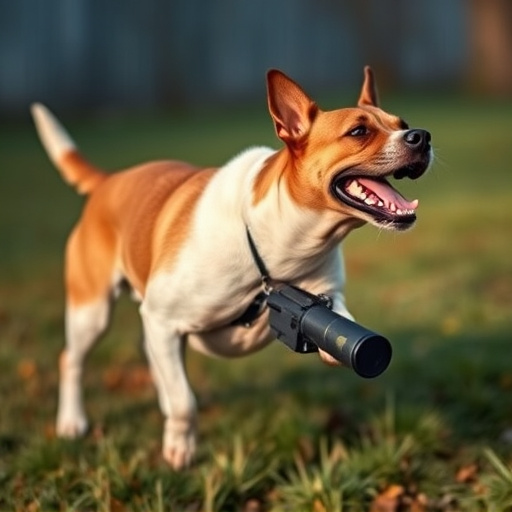Dog pepper spray, or capsaicin spray, is a legal animal control tool with advanced trigger safety features designed to prevent accidental discharge. It temporarily incapacitates aggressive dogs without causing permanent harm, making it a humane alternative to traditional methods. Usage is restricted to law enforcement and licensed specialists, and proper training is required to understand safety features like quick-release mechanisms and child-resistant packaging. Responsible use ensures public and pet safety while maintaining the spray's effectiveness in deterring dangerous canine behavior.
Animal control spray, often referred to as dog pepper spray, has gained attention for its legal use in managing aggressive animals. This article delves into the legal perspective of dog pepper spray, exploring its understanding, safety features like trigger mechanisms, responsible use guidelines, and training requirements. We also consider alternative options, providing a comprehensive view of effective animal control methods. Key focus points include trigger safety features to ensure responsible and safe implementation.
- Understanding Dog Pepper Spray: A Legal Perspective
- Safety Features in Animal Control Sprays
- Responsible Use and Training Requirements
- Exploring Alternative Options and Their Effectiveness
Understanding Dog Pepper Spray: A Legal Perspective
Dog pepper spray, also known as capsaicin spray, is a legal tool for animal control when used responsibly and in accordance with local laws. From a legal perspective, understanding the trigger safety features of dog pepper spray is crucial. These sprays are designed to temporarily incapacitate an aggressive dog without causing permanent harm, provided they are deployed correctly.
The legal use of dog pepper spray emphasizes the importance of safety measures, such as trained application and proper storage. Users must be aware of their surroundings and ensure the spray does not affect bystanders or pets. Many jurisdictions have specific regulations regarding who can possess and use this type of spray, typically restricting its use to authorized individuals like law enforcement officers or licensed animal control specialists.
Safety Features in Animal Control Sprays
Animal control sprays, especially those designed for dog pepper spray, come equipped with advanced trigger safety features to ensure responsible and controlled usage. These mechanisms are crucial in preventing accidental discharge, which could lead to harm not just for the user but also for animals and bystanders. Common safety features include lockable triggers that require a specific action to activate, such as pressing a button or pulling a lever. Some models even incorporate smart sensors that detect proximity, ensuring the spray only deploys when the user is in close contact with the target animal.
Additionally, many dog pepper sprays have child-resistant packaging and design elements. These safety measures not only safeguard children but also guarantee that the spray is used only by authorized individuals. Users should familiarize themselves with these safety features to make informed decisions during critical situations involving potentially aggressive animals, ensuring their well-being and that of others around them.
Responsible Use and Training Requirements
The responsible use of animal control spray, particularly dog pepper spray, is paramount to ensuring safety and effectiveness. Users must undergo proper training to comprehend the trigger’s safety features and application techniques. Many manufacturers equip their sprays with specific mechanisms designed to prevent accidental activation, such as quick-release triggers and child-resistant packaging. Understanding these features ensures users can deploy the spray only when necessary, minimizing risks to themselves and others.
Training programs often cover scenarios where the spray can be legally employed, adhering to local regulations. Participants learn about responsible usage, including distance and angle considerations, to prevent harm to bystanders and pets. Moreover, training emphasizes the importance of de-escalation techniques, ensuring users explore non-lethal options before resorting to pepper spray.
Exploring Alternative Options and Their Effectiveness
In addressing animal control, it’s crucial to explore a range of options beyond traditional methods. One such alternative gaining traction is dog pepper spray, designed with safety features to minimize unintended triggers. This non-lethal deterrent offers a humane solution for managing aggressive dogs while ensuring public safety.
The effectiveness of dog pepper spray lies in its ability to temporarily incapacitate an animal without causing severe harm. With advanced trigger mechanisms, users can activate the spray only when necessary, aiming it precisely at the target animal. This controlled application prevents accidental discharge and reduces the risk of damage to nearby people or pets.
The legal utilization of animal control spray, particularly dog pepper spray, is a multifaceted issue that requires a balance between public safety and responsible ownership. Understanding the trigger mechanisms and safety features integrated into these devices is essential. Proper training ensures their effective yet controlled use, minimizing risks while addressing potential threats. As we’ve explored, alternative options exist, but their effectiveness varies, making informed decisions crucial for both pet owners and animal control professionals. By adhering to legal guidelines and promoting responsible practices, we can harness the power of dog pepper spray while upholding public safety standards.
